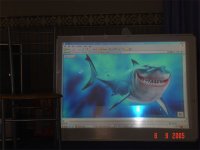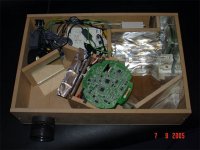I've used a 250W Hqi-ts lamp with a 5" PS one screen. Fresnels unsplit with a FL of 285mm. Projection lens is a fujinon copy lens FL 290mm ( http://www.surplusshed.com/pages/item/l3334.html ). Lamp place at 285mm from the condensor fresnel. LCD another 15mm away from the condensor fresnel. Collector fresnel 20mm away from the LCD. The projection lens is ~ 290mm from the LCD surface.
Where have I gone wrong because the image just isn't bright enough. It's only a small PS1 screen and the image size isnt even bright enough at 50".
Any help appreciated. Do you think the lamp should come closer??? Is it the LCD not good enough?
Where have I gone wrong because the image just isn't bright enough. It's only a small PS1 screen and the image size isnt even bright enough at 50".
Any help appreciated. Do you think the lamp should come closer??? Is it the LCD not good enough?
A small LCD will be dimmer, unless you shorten all the focal lengths proportionally to a 15" projector.
You need a condensor lens and a reflector.
You need a condensor lens and a reflector.
But I would've thought that the positioning of the lamp is got to do with the focal length of the fresnel and shouldn't have nothing to do with the size of the LCD?? How will shortening everything make a difference??
I've posted a pic below but it looks brighter on the pic than it really is. Also this image is with the lights out in the dark and you can see it's dim.
I've posted a pic below but it looks brighter on the pic than it really is. Also this image is with the lights out in the dark and you can see it's dim.
Attachments
Just consider the physics of it, the light shining through an LCD is only a slice of what really come out of the bulb. Imagine a sphere of light; you're trying to get as much of that sphere into the area of the LCD as possible.
A little display, at the same distance as a big display, will be dimmer because it intersects less of the total light. If you use shorter focal lengths then you can get closer to the bulb and intersect a greater percentage of the sphere. That's what a condensor lens does, it intersects more of the light and then directs it to the long focal length fresnel lens.
A little display, at the same distance as a big display, will be dimmer because it intersects less of the total light. If you use shorter focal lengths then you can get closer to the bulb and intersect a greater percentage of the sphere. That's what a condensor lens does, it intersects more of the light and then directs it to the long focal length fresnel lens.
but won't it intercept the same amount per square inch? and having a smaller area the total will be less, however won't that be non-relevant if the same magnification is used(ie if you start with 15" LCD and project a 150" diagonal then for a 5" LCD project it to 50" ) so On Screen Lumens/Area(OSLA ;-) is the same on both?
So I need to bring the lamp closer I take it. I think I can understand what you ae saying now. I will definately give that a try but how do I work out how close the lamp should come closer to the condenser fresnel? The LCD is overheating after 30 mins usage at the moment, bringing the lamp closer will make it worse and I havn'teven figured a way to sort out the overheating yet as it is so cramped!!
Also can I not use a fresnel lens (as the LCD is small) and just use a magnifying glass to spread the light around the LCD?
Also can I not use a fresnel lens (as the LCD is small) and just use a magnifying glass to spread the light around the LCD?

Attachments
things you need
1) IR filter
2) pre-condensor lens
3) reflector
exclusiv-online.com has a pretty good set of these.
The size of the LCD doesn't limit the screen image brightness. There are two things that do: How much of the lamp's output you direct through the LCD and into the projection lens, and how large a screen image you spread the light over. You can make a large image with a small LCD and vice versa. That depends on the projection lens focal length and the throw distance. But you are still stuck with the amount of light you are capturing.
A small LCD gets MUCH more light with the right pre-condensor lens. Like maybe 8 times brighter! A good spherical reflector will give you about 20% more light.
1) IR filter
2) pre-condensor lens
3) reflector
exclusiv-online.com has a pretty good set of these.
The size of the LCD doesn't limit the screen image brightness. There are two things that do: How much of the lamp's output you direct through the LCD and into the projection lens, and how large a screen image you spread the light over. You can make a large image with a small LCD and vice versa. That depends on the projection lens focal length and the throw distance. But you are still stuck with the amount of light you are capturing.
A small LCD gets MUCH more light with the right pre-condensor lens. Like maybe 8 times brighter! A good spherical reflector will give you about 20% more light.
spherical reflector
Mirrored glass reflectors with focal lengths of 0.5 to 2 meters are sold for making telescopes. They are not useful in DIY projectors. You need a nearly half-sphere with a diameter about four times the arc length of your lamp. You fit the lamp right up against it so the center of the lamp arc is at the center of curvature. (ie. 50 mm from the bottom & sides of a 100 mm diameter hemisphere.) I use a stainless steel hemisphere that has been silver plated and then mirror polished. It should be about 98% reflective, which is just a bit better than any aluminized glass front-surface mirror.
Even so, my tests (using an accurate LUX meter) show that I get only 22% more light on the screen when I use the reflector. I think the loss occurs because a spherical reflector sends the reflected rays back through the arc chamber. Some of that light probably gets absorbed or reflected by the extra four layers of glass it traverses, and maybe some gets absorbed by the arc chamber gas and re-emitted as IR.
It would be interesting to compare the theoretical versus measured difference in light on the screen, using an elliptical reflector. Those don't send rays back through the lamp arc, so I suspect they would make a much larger improvement.
Mirrored glass reflectors with focal lengths of 0.5 to 2 meters are sold for making telescopes. They are not useful in DIY projectors. You need a nearly half-sphere with a diameter about four times the arc length of your lamp. You fit the lamp right up against it so the center of the lamp arc is at the center of curvature. (ie. 50 mm from the bottom & sides of a 100 mm diameter hemisphere.) I use a stainless steel hemisphere that has been silver plated and then mirror polished. It should be about 98% reflective, which is just a bit better than any aluminized glass front-surface mirror.
Even so, my tests (using an accurate LUX meter) show that I get only 22% more light on the screen when I use the reflector. I think the loss occurs because a spherical reflector sends the reflected rays back through the arc chamber. Some of that light probably gets absorbed or reflected by the extra four layers of glass it traverses, and maybe some gets absorbed by the arc chamber gas and re-emitted as IR.
It would be interesting to compare the theoretical versus measured difference in light on the screen, using an elliptical reflector. Those don't send rays back through the lamp arc, so I suspect they would make a much larger improvement.
I'm still looking for a reflector. My mirrors used are not front surface mirrors. I really do need the one near the projection lens side to be front surface as I'm getting ghosting. I've seen a cheap reflector blanda bowl in Ikea UK. Not sure what the focal length is and if i will be ok to use.😕
- Status
- Not open for further replies.
- Home
- General Interest
- Everything Else
- The Moving Image
- DIY Projectors
- not bright enough or watchable 250W HQI-TS

